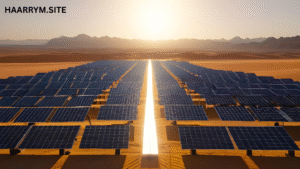If you have ever investigated solar energy, you have most likely wondered: how may solar panels help with your power bill? Reducing your electrical expenses, either entirely or just partially, appeals. The true advantages, meanwhile, go beyond just smaller monthly expenses. Knowing how solar energy interacts with your power bill enables you to make better, more environmentally friendly financial choices.
From how solar panels provide electricity to how your utility company computes your bill, this thorough guide will cover everything you need to know including how net metering, time-of-use rates, and solar savings all factor.
What Happens When You Install Solar Panels?
Understanding what occurs when you install solar panels helps you better appreciate how they could impact your power cost.
The photovoltaic (PV) effect drives solar panels to convert sunlight into energy. Usually put on your roof or ground-mounted on your property, these panels face the sun to maximize energy collecting capability.
Your solar panels begin generating direct current (DC) power after they are installed, which an inverter subsequently turns into alternating current (AC). Your house runs on this AC power.
Solar Panels and the Power Grid
Most residential solar systems are grid-tied, meaning they’re connected to your local electric utility’s power grid. This setup is crucial for two main reasons:
-
Reliability: If your panels don’t produce enough electricity (like on cloudy days or at night), you can draw power from the grid.
-
Excess Energy: If your panels produce more energy than you use, that surplus gets sent back to the grid.
This two-way relationship between your solar system and the utility grid is what directly affects your electric bill.
How Solar Panels Impact Your Electric Bill
1. Offsetting Energy Usage
When your solar panels generate electricity, your home uses that power first before tapping into the grid. This reduces the amount of electricity you need to buy from the utility.
For example, if your home uses 1,000 kWh in a month and your solar panels generate 700 kWh, your utility bill will only be based on the remaining 300 kWh you pulled from the grid.
2. Net Metering: Getting Credit for Excess Power
One of the most important concepts in understanding your electric bill with solar is net metering.
What is net metering?
Net metering is a billing arrangement where your utility gives you credit for any extra electricity your solar panels send back to the grid. These credits offset the electricity you pull from the grid when your system isn’t generating power (like at night).
Here’s how it works:
-
During sunny hours, your system may produce more electricity than your home needs.
-
That excess is sent back to the grid.
-
Your utility tracks how much surplus energy you supply and gives you a credit on your bill.
-
At night or during cloudy days, you use those credits instead of paying cash.
Some utility companies even allow these credits to roll over month-to-month or pay you for unused credits at the end of the year, although policies vary by region.
3. Minimum Monthly Charges
Even with a solar system, most utility companies charge a minimum monthly service fee (often around $10–$30). This fee covers infrastructure maintenance, grid connection, and meter readings.
So while your electricity usage may drop to zero, you might still see a small monthly bill.
Time-of-Use Rates and Solar Panels
Some utilities use a time-of-use (TOU) rate structure, where electricity prices vary depending on the time of day and demand. Rates are usually higher during peak hours (e.g., 4 PM – 9 PM) and lower during off-peak hours (e.g., overnight).
Solar panels produce most of their electricity during the day — often during off-peak hours. If your utility uses TOU pricing, you might not get as much value for your solar energy unless you:
-
Shift your electricity usage to solar-peak hours
-
Install a solar battery to store energy for use during expensive peak hours
How to Read Your Electric Bill with Solar Panels
Reading your post-solar electric bill may seem confusing at first, but here are the key components you’ll see:
1. Electricity Usage (kWh)
This shows how much electricity you consumed from the grid and how much you sent back. It might be shown as:
-
Total kWh used
-
Total solar production
-
Net usage or net metering balance
2. Net Metering Credits
Your utility may show credits you’ve earned for sending electricity back to the grid. These will be used to reduce your bill during high-usage times or carried over to future months.
3. Minimum Charges and Taxes
These may include:
-
Grid maintenance fees
-
Service connection charges
-
Taxes or renewable energy surcharges
Even if you’re producing 100% of your energy needs with solar, you might still see these on your bill.
Monthly Savings: What Can You Expect?
The amount you save each month depends on several factors:
-
Your system size
-
Local electricity rates
-
Your home’s energy consumption
-
Net metering policies in your area
Example:
Let’s say your average monthly electric bill is $150. After installing a solar system that meets 80% of your energy needs, your new bill might drop to $30–$40 per month — or even lower, depending on your location and system efficiency.
Over a year, this could mean $1,300–$1,500 in savings, and over 25 years, you could save $30,000 or more.
Annual True-Up Bill (for Some Utilities)
Some utilities offer annual true-up billing, especially in California and other solar-heavy states.
What’s a True-Up Bill?
Instead of monthly charges, your utility tracks your energy usage and solar production throughout the year. At the end of the 12-month billing cycle, they calculate your total net usage:
-
If you used more than you produced, you pay the difference.
-
If you produced more than you used, you might get paid for the surplus or roll the credit forward.
This approach benefits homeowners with seasonal energy patterns, like high usage in summer (AC) and low in winter.
Can You Eliminate Your Electric Bill Completely?
Yes — but with some caveats.
To eliminate your electric bill entirely:
-
Your solar system must generate at least as much electricity as you use annually.
-
Your utility must offer full-retail net metering.
-
You’ll still have to pay minimum service charges in most cases.
To go completely off-grid (and avoid utility bills entirely), you’d need:
-
A solar panel system large enough to meet all your energy needs year-round
-
A battery storage system (like Tesla Powerwall or similar)
-
Backup power solutions (like generators)
However, most people stay grid-connected for convenience, cost-effectiveness, and reliability.
Solar Batteries and Their Role in Electric Bills
Adding a solar battery to your system can reduce your electric bill even more.
How?
-
You store excess solar energy during the day
-
Use that stored energy at night or during peak-rate hours
-
Reduce how much electricity you buy from the grid
In areas without full net metering, batteries can maximize the value of your solar investment.
Example:
If peak grid rates are $0.30/kWh and your solar battery helps you avoid using grid power during those times, you save more money than if you were credited at a lower rate.
Incentives That Reduce Solar Costs
Reducing your electric bill is just one part of the savings. You can also take advantage of:
-
Federal Solar Investment Tax Credit (ITC) – Currently at 30%
-
State and local rebates
-
Solar Renewable Energy Certificates (SRECs) in some states
-
Net metering programs that pay you for surplus electricity
These incentives make solar more affordable and can increase your return on investment.
Solar and Electric Bills: Pros and Cons
✅ Pros:
-
Lower monthly electricity bills
-
Protection from rising energy rates
-
Potential for bill credits or payments
-
Increased home value
-
Environmental benefits
❌ Cons:
-
Upfront costs (though financing and incentives help)
-
Utility policies vary by region
-
May not eliminate your bill entirely
Final Thoughts: Solar Panels & Your Electric Bill
How then does your power bill interact with solar panels? Essentially:
They either minimize or balance your grid-based energy use. Your power cost may be drastically cut—or almost completely eliminated—if your system is big enough and your utility allows net metering. Sometimes, too, your extra energy might result in credits or cash.
Your energy use, local legislation, and system design will determine the precise effect; for most homes, solar provides stability in a period of growing utility bills and long-term savings.
Ready to Start Saving?
Now that you know how solar panels work with your electric bill, it’s time to take action. Get quotes from local solar installers, compare net metering policies in your area, and calculate how much you could save.
Go solar — and watch your electric bill shrink.

